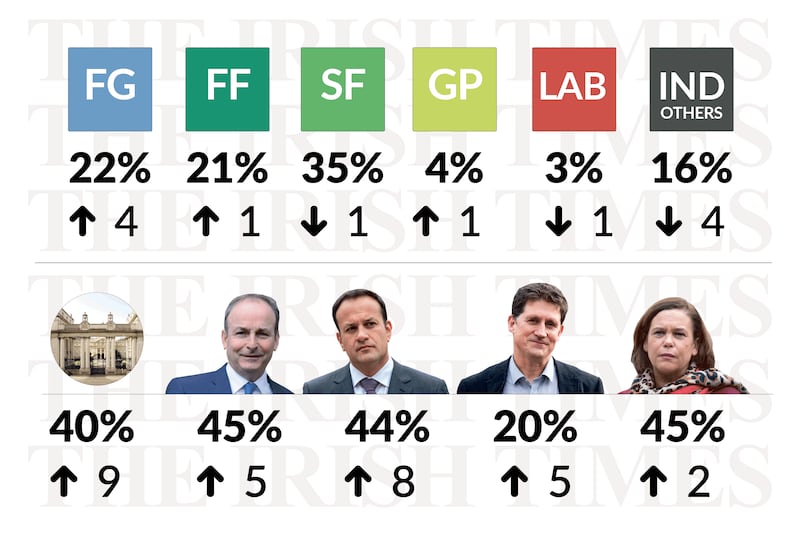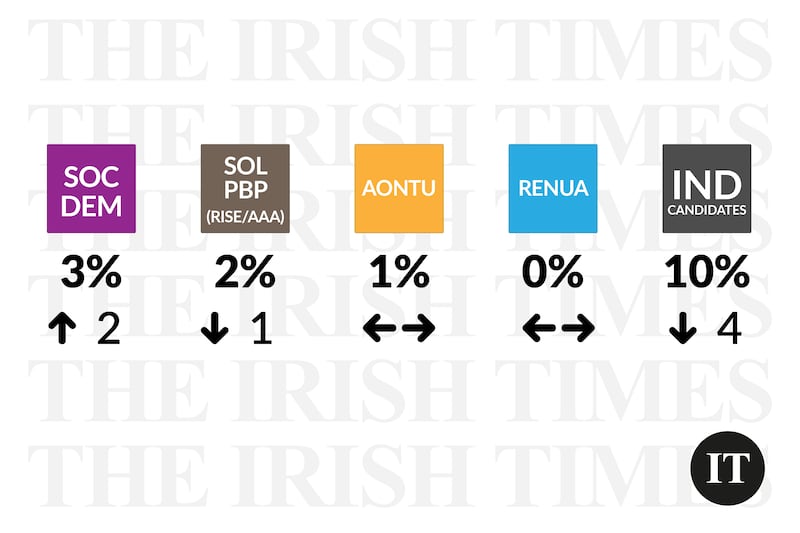The latest Irish Times/Ipsos poll reveals a noticeable lift in support for the Government, on the back of a giveaway budget and a growing recognition that the Irish economy is well positioned to weather any storms that may be brewing in Europe and around the world.
Clearly, Budget 2023 was well received, with the Government’s satisfaction rating rebounding, up nine points to 40 per cent. Combined support for the Government parties is also up, to 47 per cent from 41 per cent in our July poll.
Fine Gael appear to have benefitted the most from the budget bounce (up four points to 22 per cent). Only marginal gains are registered for Fianna Fáil (up one point to 21 per cent) and the Green Party (up one point to 4 per cent).
Improved poll ratings for the parties of Government have not come, to any great extent, at the expense of Sinn Féin who remain the most popular party in Ireland, with 35 per cent support (down one point).
READ MORE

Fieldwork for today’s poll took place on Sunday, Monday and Tuesday of this week, among a nationally representative sample of 1,200 eligible voters. Irish Times/Ipsos polls are conducted face-to-face, in-home, across every county and constituency.
The backdrop to today’s poll is dominated by the energy crisis and the rising cost of living. Such is the concern over inflation and its impact on living standards, other matters of huge importance – housing, the war in Ukraine, a stuttering global economy, chaos in UK politics, stalemate in Northern Irish politics – have been somewhat overshadowed.
Consistently over the past year, Sinn Féin have enjoyed a double-digit lead over both Fine Gael and Fianna Fáil
Ironically, the current global turmoil has only served to highlight the strength of the Irish economy and the stability of the Irish Government. Despite this, support for the combined parties of Government – at 47 per cent – would not guarantee a return to power if a general election were to be held tomorrow.
Whether or not 47 per cent combined support suggests an appetite for change is debatable. Not up for debate is the party to which disaffected voters are looking to form an alternative government at the next election. Consistently over the past year, Sinn Féin have enjoyed a double-digit lead over both Fine Gael and Fianna Fáil.
[ Pat Leahy analysis: Coalition gets unexpected opinion poll pick-me-upOpens in new window ]
There are only a few demographics groupings among whom Sinn Féin do not take the top spot, namely the over 65s (24 per cent, compared to 34 per cent for Fianna Fáil and 25 per cent for Fine Gael), the AB socio-economic group (24 per cent, versus 33 per cent for Fine Gael) and voters from farming backgrounds (18 per cent, versus 38 per cent for Fianna Fáil and 32 per cent for Fine Gael).
Thus far, Labour have not made a compelling case to disgruntled voters, with just 3 per cent support in this October poll. The party is strongest in Dublin (6 per cent) and among middle-class voters (4 per cent).
Also on 3 per cent (up one point) are the Social Democrats, with Solidarity/People Before Profit on 2 per cent (down one point) and Aontú on 1 per cent (no change).
Independent candidates attract a 10 per cent share of the vote, down four points. Between the 2017 and 2022 elections, Independents witnessed a lull in support, so a mid-term dip is not unusual.

The September budget was an opportunity for the Government to convince the electorate that change was not needed. Progress has been clearly made, at a time when progress was by no means assured with so many voters concerned about the rising cost of living.
The poll findings highlight how challenging it will be for the three Government parties combined to break through the 50 per cent barrier
Fine Gael recorded a lift of four points, to 22 per cent. Party leader Leo Varadkar’s satisfaction rating enjoyed even more of a bounce, up eight points to 44 per cent. Regionally, Fine Gael’s base is quite evenly distributed – Dublin (24 per cent), Rest of Leinster (20 per cent), Munster (23 per cent) and Connacht/Ulster (20 per cent).
Fianna Fáil have edged marginally higher, up one point to 21 per cent. Micheál Martin, who in December will hand over the reins to Varadkar, is departing his post as the most popular party leader, with a 45 per cent satisfaction rating, up five points since July.
Fianna Fáil are notably weaker in the capital than outside – Dublin (9 per cent), Rest of Leinster (21 per cent), Munster (27 per cent) and Connacht/Ulster (28 per cent).
The Greens, on 4 per cent (up one point), remain some way adrift of their General Election 2020 result of 7 per cent. Age-wise, support for the party is highly skewed, ranging from 12 per cent among 18 to 24 year olds, to 1 per cent among the over 65s.
Today’s poll findings are positive for the Government, yet at the same time they highlight how challenging it will be for the three parties combined to break through the 50 per cent barrier. Coalition means not having access to voters who are instinctively anti-government, except of course in times of crisis like the Covid pandemic. The next two and a half years is shaping up to be a tug of war, as the Government and Sinn Féin battle it out for the middle ground.
Damian Loscher is Ipsos Ireland managing director













